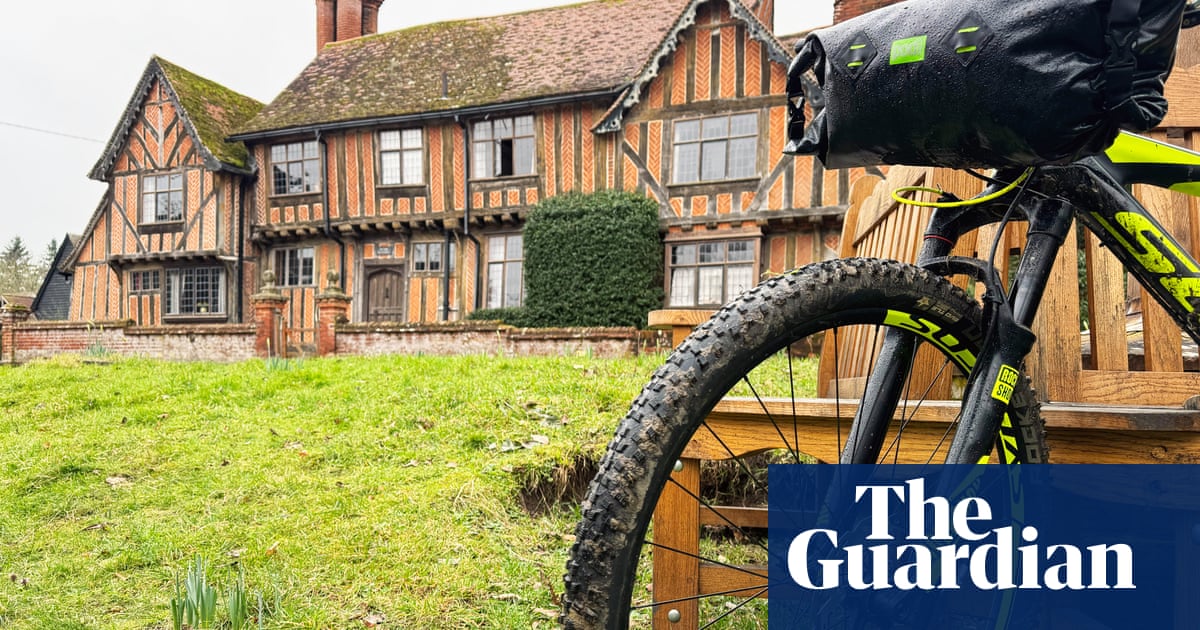
It was an inauspicious start. Having cycled no more than a few metres, from the steps of the Angel hotel into the grounds of St Edmundsbury Cathedral, I fell off my bike.
I blamed the wolf: in dismounting to take its photo, I had kicked my own pannier and sent myself sprawling. The good passersby of Bury St Edmunds came to my (embarrassed) aid. Saint Edmund himself, sculpted in bronze, standing beside the wolf statue, looked the other way.
I could hardly complain about grazed knees in such company. After refusing to renounce his Christianity to Viking raiders in AD869, Edmund – then king of East Anglia – was shot full of arrows and beheaded. According to legend, his head was later found being guarded by a wolf, and when reunited with his body, miraculously fused back on.
Thus the wolf is an important symbol in Suffolk, which is why a newly launched 400km (248 miles) cycling trail has been called the Wolf Way. Using bridleways, byways, gravel tracks, cycle paths and quiet backroads, the route weaves around the highlights and hidden corners of this largely flat but varied county. It was inspired by Norfolk’s Rebellion Way, opened in 2022. But while Rebellion was developed by Cycling UK with funding from the European Regional Development Fund Experience project, local couple Sharon Calton and Chris Bower put the Wolf together with nowt but their own legwork and enthusiasm.
“We came up with an outline of the route in an afternoon, and took a year to fine-tune it,” Sharon told me at their cottage just outside Bury. “We needed to test it, ride the roads, find the best options – recce-ing has been time-consuming but fun.”
When I rolled into Long Melford, having covered 28 miles, I was splattered in mud but genuinely having a ball
Discover Suffolk has given advice, ensuring the Wolf Way sticks to permitted rights of way, but otherwise this project is the result of two cycle-passionate amateurs seeking only to encourage more people to explore this under-pedalled county.
The result is a satisfying loop, roughly a third off-road, that rides into the lesser-visited reaches of Dedham Vale, down the River Orwell, through the Suffolk & Essex Coast & Heaths national landscape (the designation that has replaced “area of outstanding natural beauty”) and into the wonderfully weird Brecks, taking in everything from neolithic settlements to lost seaside cities, medieval wool towns, UFO sites and the village of Hoxne (where Edmund allegedly lost his head). Chris has created an excellent digital StoryMap to accompany the route, which flags up places of interest along the way, with useful web links, while the Wolf Way Facebook group is a good place to pick up tips from other riders.
There are also variants, including a 100km (62-mile) Wolf Cub route, a Winter Wolf suggestion, which avoids the seasonal Bawdsey ferry, and a beginner-friendly 13km (8-mile) Wolverine option. An 80km (50-mile) option will be added too.
I’d come to sample a section of the original Wolf Way, starting from Bury and cycling to Ipswich (roughly 97km/60 miles). On the plus side, this meant spending time in the handsome market town, with its extensive abbey ruins and what must be the country’s most impressive Wetherspoon’s, housed in the old neoclassical Corn Exchange. On the downside I had, said Sharon, picked the route’s hilliest bit.
No matter, it was hardly mountainous – this was still Suffolk after all – and I was in no rush. I’d borrowed a mountain bike from Sharon – a hybrid or gravel bike would also be fine – though Maglia Rosso, a few miles outside Bury by bus, hires out bicycles. Leaving Bury via well-marked cycle paths, I was soon out in the countryside, tootling along lanes lined with just-budding fields. I met a hare, preening on the road, while kestrels and buzzards gave low flybys. Then a grassy off-road trail provided a more sobering encounter: a plaque marking the site where a USA air force B-17 crashed, with the loss of all 10 crew, on 27 March 1944; the cause was never officially established, but there were rumours of sabotage by German spies.
East Anglia was dotted with USAAF bases during the second world war. There was one just outside Lavenham, where I cycled to next. Back then the village was flooded with American troops. Now it’s full of Harry Potter fans, looking for the wizard’s birthplace, which was played in the movies by timber-framed De Vere House – just one of more than 320 listed buildings in what is considered to be England’s best-preserved medieval village.
Lavenham was extraordinarily cute, but I decided to overlook its tearooms and pushed on to little Brent Eleigh instead. As well as a church concealing some of the earliest and finest medieval wall paintings in Britain, the village is home to Cafe Como. Run by Miranda Elgar, in a funky outbuilding in her farmyard, it’s exactly the sort of independent business the Wolf Way hopes to support. “About 80% of my customers are cyclists,” Miranda told me, handing over a homemade sausage roll and an excellent coffee. “I lived in Italy for many years, and wanted to bring a bit of it back to Suffolk.”
This was good fuel for the next stiff-ish climb, and a skiddy ride on a section of messy single-track. Suffolk is ordinarily one of the country’s driest counties, and most other sections of the Wolf Way, which traverses areas of quick-draining sandy soil, remain remarkably firm year-round. Alas, I’d chosen the wettest bit of the route after Suffolk’s wettest winter on record. When I rolled into Long Melford, having covered 28 miles, I was splattered in mud but genuinely having a ball.
I soon cleaned myself up at the cosy Black Lion, home for the night. And I had enough energy left to wander the independent-lined high street – which is, as the village’s name suggests, very, very long – and pop into the huge, light-flooded church. The medieval stained glass here is extraordinary; a surprisingly large amount survived the Reformation, and is in the process of being restored.
After a good, lazy breakfast, I set off late, waiting for winter sun to chase off the rain; my aim was Ipswich, 30-odd miles away. The route crosses briefly into Essex, picking up part of the old Great Eastern Railway line, now a walking and biking trail leading to Sudbury, Gainsborough’s birthplace. Indeed, with low light glinting off low hills, the River Stour cutting through, and everything well watered and green, it looked like one of his landscape paintings.
From here, climbs and floods added challenges. Ipswich was still some way off, but I got distracted in Bures. Outside this pretty county-border village, up Cuckoo Hill and so hidden down a farm track I wondered if I’d gone awry, lies the lonely thatched chapel of St Stephen. It was consecrated on Boxing Day, 1218. However, according to legend, it stands on the site where Edmund was crowned King of the East Angles on Christmas Day 855, aged just 14.
Another local folk tale tells of “an evil dragon of excessive length” plaguing the area around here in the early 15th century. To mark the Queen’s diamond jubilee, the huge beast was marked out on the slopes opposite, using tonnes of chalk. The field behind the chapel provided the perfect dragon view.
No wolf, then, but a ride into so many different Suffolk stories.












